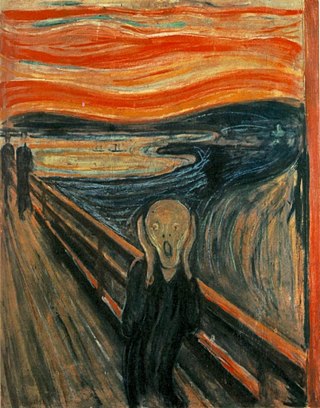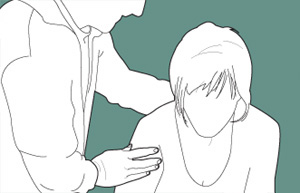An anxiolytic is a medication or other intervention that reduces anxiety. This effect is in contrast to anxiogenic agents which increase anxiety. Anxiolytic medications are used for the treatment of anxiety disorders and their related psychological and physical symptoms.

Cognitive behavioral therapy (CBT) is a psycho-social intervention that aims to reduce symptoms of various mental health conditions, primarily depression and anxiety disorders. Cognitive behavioral therapy is one of the most effective means of treatment for substance abuse and co-occurring mental health disorders. CBT focuses on challenging and changing cognitive distortions and their associated behaviors to improve emotional regulation and develop personal coping strategies that target solving current problems. Though it was originally designed to treat depression, its uses have been expanded to include the treatment of many mental health conditions, including anxiety, substance use disorders, marital problems, ADHD, and eating disorders. CBT includes a number of cognitive or behavioral psychotherapies that treat defined psychopathologies using evidence-based techniques and strategies.

A phobia is an anxiety disorder, defined by a persistent and excessive fear of an object or situation. Phobias typically result in a rapid onset of fear and are usually present for more than six months. Those affected go to great lengths to avoid the situation or object, to a degree greater than the actual danger posed. If the object or situation cannot be avoided, they experience significant distress. Other symptoms can include fainting, which may occur in blood or injury phobia, and panic attacks, often found in agoraphobia and emetophobia. Around 75% of those with phobias have multiple phobias.

Anxiety disorders are a cluster of mental disorders characterized by significant and uncontrollable feelings of anxiety and fear such that a person's social, occupational, and personal function are significantly impaired. Anxiety may cause physical and cognitive symptoms, such as restlessness, irritability, easy fatiguability, difficulty concentrating, increased heart rate, chest pain, abdominal pain, and a variety of other symptoms that may vary based on the individual.

Agoraphobia is a mental and behavioral disorder, specifically an anxiety disorder characterized by symptoms of anxiety in situations where the person perceives their environment to be unsafe with no easy way to escape. These situations can include open spaces, public transit, shopping centers, crowds and queues, or simply being outside their home on their own. Being in these situations may result in a panic attack. Those affected will go to great lengths to avoid these situations. In severe cases, people may become completely unable to leave their homes.

Panic attacks are sudden periods of intense fear and discomfort that may include palpitations, sweating, chest pain or chest discomfort, shortness of breath, trembling, dizziness, numbness, confusion, or a feeling of impending doom or of losing control. Typically, symptoms reach a peak within ten minutes of onset, and last for roughly 30 minutes, but the duration can vary from seconds to hours. Although they can be extremely frightening and distressing, panic attacks themselves are not physically dangerous.
Specific phobia is an anxiety disorder, characterized by an extreme, unreasonable, and irrational fear associated with a specific object, situation, or concept which poses little or no actual danger. Specific phobia can lead to avoidance of the object or situation, persistence of the fear, and significant distress or problems functioning associated with the fear. A phobia can be the fear of anything.
Emetophobia is a phobia that causes overwhelming, intense anxiety pertaining to vomit. This specific phobia can also include subcategories of what causes the anxiety, including a fear of vomiting or seeing others vomit. Emetephobes might also avoid the mentions of "barfing", vomiting, "throwing up", or "puking."

Generalized anxiety disorder (GAD) is a mental and behavioral disorder, specifically an anxiety disorder characterized by excessive, uncontrollable and often irrational worry about events or activities. Worry often interferes with daily functioning, and individuals with GAD are often overly concerned about everyday matters such as health, finances, death, family, relationship concerns, or work difficulties. Symptoms may include excessive worry, restlessness, trouble sleeping, exhaustion, irritability, sweating, and trembling.
Selective mutism (SM) is an anxiety disorder in which a person who is otherwise capable of speech becomes unable to speak when exposed to specific situations, specific places, or to specific people, one or multiple of which serving as triggers. This is caused by the freeze response. Selective mutism usually co-exists with social anxiety disorder. People with selective mutism stay silent even when the consequences of their silence include shame, social ostracism, or punishment.
Mysophobia, also known as verminophobia, germophobia, germaphobia, bacillophobia and bacteriophobia, is a pathological fear of contamination and germs. It is classified as a type of specific phobia, meaning it is evaluated and diagnosed based on the experience of high levels of fear and anxiety beyond what is reasonable when exposed to or in anticipation of exposure to stimuli related to the particular concept. William A. Hammond first coined the term in 1879 when describing a case of obsessive–compulsive disorder (OCD) exhibited in repeatedly washing one's hands.
Exposure therapy is a technique in behavior therapy to treat anxiety disorders. Exposure therapy involves exposing the target patient to the anxiety source or its context without the intention to cause any danger (desensitization). Doing so is thought to help them overcome their anxiety or distress. Procedurally, it is similar to the fear extinction paradigm developed for studying laboratory rodents. Numerous studies have demonstrated its effectiveness in the treatment of disorders such as generalized anxiety disorder, social anxiety disorder, obsessive-compulsive disorder, post-traumatic stress disorder (PTSD), and specific phobias.
Social anxiety is the anxiety and fear specifically linked to being in social settings. Some categories of disorders associated with social anxiety include anxiety disorders, mood disorders, autism spectrum disorders, eating disorders, and substance use disorders. Individuals with higher levels of social anxiety often avert their gazes, show fewer facial expressions, and show difficulty with initiating and maintaining a conversation. Social anxiety commonly manifests itself in the teenage years and can be persistent throughout life; however, people who experience problems in their daily functioning for an extended period of time can develop social anxiety disorder. Trait social anxiety, the stable tendency to experience this anxiety, can be distinguished from state anxiety, the momentary response to a particular social stimulus. Half of the individuals with any social fears meet the criteria for social anxiety disorder. Age, culture, and gender impact the severity of this disorder. The function of social anxiety is to increase arousal and attention to social interactions, inhibit unwanted social behavior, and motivate preparation for future social situations.

Thalassophobia is the persistent and intense fear of deep bodies of water such as the sea, oceans, or lakes. Though very closely related, thalassophobia should not be confused with aquaphobia which is classified as the fear of water itself. Thalassophobia can include fear of being in deep bodies of water, fear of the vast emptiness of the sea, of sea waves, aquatic creatures, and fear of distance from land.

Interoceptive exposure is a cognitive behavioral therapy technique used in the treatment of panic disorder. It refers to carrying out exercises that bring about the physical sensations of a panic attack, such as hyperventilation and high muscle tension, and in the process removing the patient's conditioned response that the physical sensations will cause an attack to happen.

Depression is a mental disorder characterized by prolonged unhappiness or irritability, accompanied by a constellation of somatic and cognitive signs and symptoms such as fatigue, apathy, sleep problems, loss of appetite, loss of engagement. low self-regard/worthlessness, difficulty concentrating/indecisiveness, or recurrent thoughts of death or suicide. Depression in childhood and adolescence is similar to adult major depressive disorder, although young sufferers may exhibit increased irritability or behavioral dyscontrol instead of the more common sad, empty, or hopeless feelings seen with adults. Children who are under stress, experiencing loss, or have other underlying disorders are at a higher risk for depression. Childhood depression is often comorbid with mental disorders outside of other mood disorders; most commonly anxiety disorder and conduct disorder. Depression also tends to run in families. In a 2016 Cochrane review cognitive behavior therapy (CBT), third-wave CBT and interpersonal therapy demonstrated small positive benefits in the prevention of depression. Psychologists have developed different treatments to assist children and adolescents suffering from depression, though the legitimacy of the diagnosis of childhood depression as a psychiatric disorder, as well as the efficacy of various methods of assessment and treatment, remains controversial.

Social anxiety disorder (SAD), also known as social phobia, is an anxiety disorder characterized by sentiments of fear and anxiety in social situations, causing considerable distress and impairing ability to function in at least some aspects of daily life. These fears can be triggered by perceived or actual scrutiny from others. Individuals with social anxiety disorder fear negative evaluations from other people.

Panic disorder is a mental and behavioral disorder, specifically an anxiety disorder characterized by reoccurring unexpected panic attacks. Panic attacks are sudden periods of intense fear that may include palpitations, sweating, shaking, shortness of breath, numbness, or a feeling that something terrible is going to happen. The maximum degree of symptoms occurs within minutes. There may be ongoing worries about having further attacks and avoidance of places where attacks have occurred in the past.
PTSD or post-traumatic stress disorder, is a psychiatric disorder characterised by intrusive thoughts and memories, dreams or flashbacks of the event; avoidance of people, places and activities that remind the individual of the event; ongoing negative beliefs about oneself or the world, mood changes and persistent feelings of anger, guilt or fear; alterations in arousal such as increased irritability, angry outbursts, being hypervigilant, or having difficulty with concentration and sleep.
Separation anxiety disorder (SAD) is an anxiety disorder in which an individual experiences excessive anxiety regarding separation from home and/or from people to whom the individual has a strong emotional attachment. Separation anxiety is a natural part of the developmental process. It is most common in infants and little children, typically between the ages of six to seven months to three years, although it may pathologically manifest itself in older children, adolescents and adults. Unlike SAD, normal separation anxiety indicates healthy advancements in a child's cognitive maturation and should not be considered a developing behavioral problem.









